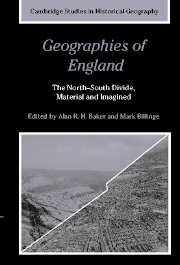Book contents
- Frontmatter
- Contents
- List of figures
- List of tables
- List of contributors
- Preface
- 1 Material and imagined geographies of England
- 2 The contemporary debate over the North–South divide: images and realities of regional inequality in late-twentieth-century Britain
- 3 Distressed times and areas: poverty, polarisation and politics in England, 1918–1971
- 4 Industry and identity: the North–South divide and the geography of belonging, 1830–1918
- 5 Divided by a common language: North and South, 1750–1830
- 6 South, North and nation: regional differences and consciousness in an integrating realm, 1550–1750
- 7 North–South dichotomies, 1066–1550
- 8 Cultural constructions of England's geography and history
- References
- Index
- Cambridge Studies in Historical Geography
8 - Cultural constructions of England's geography and history
Published online by Cambridge University Press: 10 December 2009
- Frontmatter
- Contents
- List of figures
- List of tables
- List of contributors
- Preface
- 1 Material and imagined geographies of England
- 2 The contemporary debate over the North–South divide: images and realities of regional inequality in late-twentieth-century Britain
- 3 Distressed times and areas: poverty, polarisation and politics in England, 1918–1971
- 4 Industry and identity: the North–South divide and the geography of belonging, 1830–1918
- 5 Divided by a common language: North and South, 1750–1830
- 6 South, North and nation: regional differences and consciousness in an integrating realm, 1550–1750
- 7 North–South dichotomies, 1066–1550
- 8 Cultural constructions of England's geography and history
- References
- Index
- Cambridge Studies in Historical Geography
Summary
Standard questions about the nature of any North–South divide in England during particular historical periods have not produced standard answers. This is hardly surprising, given the country's changing geography during the last millennium and the differing intellectual baggages brought to this project by its contributors. Nonetheless, it is possible to unravel some common threads running throughout these essays and we want here to identify a few of them. Both the character and the historical status of England's North–South divide have been explored. The concept of such a divide is deeply embedded in today's popular culture and frequently brought to the surface by today's media, which feeds on oppositions and conflicts. But it has also been shown to have deep historical roots.
A negative image of the North has been cultivated in recent decades in travel writing, in television documentaries, in novels and in films. Reflecting upon recent such works, Raphael Samuel concluded:
In any of these literatures, the North of England is apt to fare badly. As the original home of many of this country's staple industries it is peculiarly vulnerable to the charge of being economically moribund. Gastronomically, the people are accused of being overweight and addicted to an unhealthy diet. Environmentally, the North was the great victim of the planning disasters of the 1960s, having more than its fair share of multi-storey car parks, express throughways and ‘peripheral’ council estates. Medically, as the statistics on lung cancer, heart disease and infant mortality never fail to record, it lags behind the rest of Britain. […]
- Type
- Chapter
- Information
- Geographies of EnglandThe North-South Divide, Material and Imagined, pp. 175 - 183Publisher: Cambridge University PressPrint publication year: 2004



